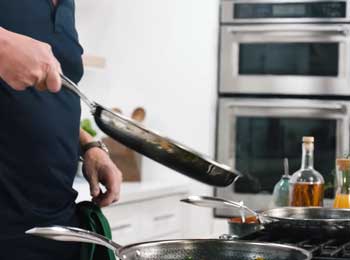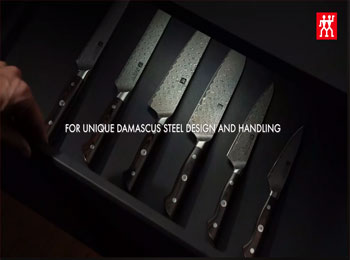Cooking enthusiasts are no strangers to the constant quest for the perfect kitchen tools that can elevate their culinary creations. In the world of cookware, two prominent contenders, HexClad and ZWILLING, have been making waves with their innovative designs and exceptional quality.
But which one truly reigns supreme in the battle of HexClad vs ZWILLING? Join us as we delve into a comprehensive comparison, dissecting their pros and cons, unraveling unique features, and helping you make an informed decision for your kitchen arsenal.
A Brief Comparison Table
Before we plunge into the nitty-gritty details, let’s set the stage with a quick comparison of the main features of HexClad and ZWILLING.
| Aspect | HexClad | ZWILLING |
| Core Material | Stainless Steel/Aluminum/Non-Stick | Various options including Carbon Steel |
| Heat Distribution | Tri-ply construction for even heat spread | Specialty designs for precise heat control |
| Surface | Hexagonal Stainless Steel/Non-Stick | Various options including Damascus pattern |
| Durability | Scratch-resistant and sturdy | Highly durable with proper maintenance |
| Handle | Riveted Stainless Steel with heat resistance | Ergonomic designs for comfortable grip |
| Versatility | Oven-safe, compatible with various stovetops | Diverse ranges for specific cooking tasks |
| Price Range | Mid to high | Mid to high |
Now, let’s dive into the intricacies of each contender.
Overview of HexClad
HexClad, a relative newcomer to the cookware scene, has managed to carve a niche for itself with its unique hexagonal design that combines the benefits of both stainless steel and non-stick surfaces.

The innovative construction of HexClad cookware involves a tri-ply combination of stainless steel, aluminum, and non-stick materials. This amalgamation ensures remarkable heat distribution, making hotspots a thing of the past.
The hexagonal pattern on the cooking surface isn’t just for aesthetics. It serves a functional purpose by allowing better food release and preventing sticking, even with minimal oil or butter.
This is a true blessing for those aiming to cook healthier meals without compromising on flavor. Moreover, the scratch-resistant nature of HexClad cookware ensures that your investment will stand the test of time.
HexClad’s stainless steel handles are riveted for sturdiness and heat resistance, offering a secure grip while transferring your creations from stove to oven. This versatility adds an extra layer of convenience, allowing you to experiment with a wider array of recipes.
Overview of ZWILLING
ZWILLING, a brand with a rich history dating back to 1731, has become synonymous with exceptional kitchen knives and cookware. One of their standout offerings, the ZWILLING Pro line, has gained substantial attention for its precision, durability, and remarkable performance.
One of the key distinctions of ZWILLING Pro cookware lies in its choice of core materials. While HexClad employs a combination of stainless steel, aluminum, and non-stick, ZWILLING Pro employs different options including carbon steel.
Carbon steel brings its own set of advantages, including outstanding heat retention and distribution. This is particularly beneficial for searing, browning, and achieving that perfect crust on your dishes.
One of the hallmarks of ZWILLING Pro cookware is its focus on precise heat control. The construction and design of these pieces are optimized to give you the ability to fine-tune your cooking temperatures, which is essential for delicate techniques like sautéing and simmering.
ZWILLING Pro’s handles are crafted with ergonomic designs that prioritize comfort during long cooking sessions. The combination of form and function is a testament to ZWILLING’s commitment to delivering a superior cooking experience.
Also Read: Comparison Between All-Clad Essentials and Hard Anodized
Key Differences Between HexClad And ZWILLING
Now, let’s take a closer look at some crucial aspects where HexClad and ZWILLING diverge, helping you understand which one aligns better with your culinary needs.
- Cookware Type and Material:

HexClad cookware is uniquely designed with a combination of stainless steel and nonstick ceramic. This innovative hybrid construction brings together the durability of stainless steel with the nonstick properties of ceramic.
On the other hand, ZWILLING offers a versatile range of cookware types, including both stainless steel and nonstick options. ZWILLING’s cookware often features multi-layered construction, which can include materials like stainless steel or copper. These layers are designed to promote even heat distribution and precise cooking results.
- Core Material and Heat Distribution:
HexClad cookware boasts an aluminum core at its heart. Aluminum is an excellent conductor of heat, ensuring that the cookware heats up quickly and spreads the heat evenly across the cooking surface. In comparison, ZWILLING employs multi-layered cores, such as stainless steel or copper.
These cores are carefully chosen for their ability to offer precise heat control, which is crucial for achieving optimal cooking results, especially for dishes that require precise temperature management.
- Handle Design:
HexClad cookware is equipped with ergonomic handles that are designed for a comfortable grip. These handles are heat-resistant, ensuring that you can safely handle the cookware even when it’s hot. The design of these handles also contributes to the cookware’s sleek and modern appearance.
In contrast, ZWILLING cookware features riveted handles. These handles are securely attached to the cookware and are known for their durability. They provide a strong and reliable grip, which is essential for safely moving and maneuvering the cookware during cooking.
Also Read: Comparison Between the Cangshan L1 and S1
- Compatibility:
Both HexClad and ZWILLING cookware are versatile in terms of compatibility. They are suitable for use on all types of stovetops, including induction. This means that regardless of the type of stovetop you have, you can confidently use either HexClad or ZWILLING cookware without any concerns about compatibility.
Also watch this video:
- Oven-Safe Temperature:
When it comes to oven use, both HexClad and ZWILLING cookware are designed to handle high temperatures. You can safely use them in the oven at temperatures up to 500°F (260°C).
This feature adds versatility to your cooking options, allowing you to start cooking on the stovetop and finish dishes in the oven without needing to switch to different cookware.
- Maintenance:
HexClad cookware is dishwasher safe, which means you can save time on cleanup by placing them in the dishwasher.
However, to ensure the longevity of the nonstick ceramic surface and the overall quality of the cookware, it’s recommended to handwash HexClad. On the other hand, ZWILLING suggests handwashing for their stainless steel cookware to maintain its appearance and performance over time.
- Price Range:
Both HexClad and ZWILLING cookware fall within a similar price range, which can be considered mid to high. HexClad’s pricing reflects its innovative hybrid design that combines stainless steel and nonstick ceramic.
ZWILLING’s positioning in the mid to high price range aligns with its reputation as a brand that offers quality and durability in its cookware products.
Also Read: Comparison Between Swiss Diamond And HexClad
Frequently Asked Questions (FAQs)
HexClad stands out due to its distinctive hexagonal design that combines stainless steel, aluminum, and non-stick for exceptional heat distribution and food release.
HexClad’s surface is designed to be scratch-resistant, allowing you to use metal utensils without damaging the cookware.
ZWILLING Pro focuses on precise heat control and often incorporates carbon steel for enhanced heat retention, making it ideal for searing and controlled cooking techniques.
ZWILLING produces both forged and stamped knives, each with its own benefits. Forged knives are known for their durability and balance, while stamped knives are more lightweight and affordable.
Also Read: Choose Between Legend And All-Clad
Final Thought
In the HexClad vs ZWILLING showdown, the choice ultimately comes down to your personal cooking style, preferences, and budget. HexClad’s innovative hybrid design is perfect for those who crave the convenience of nonstick cookware without sacrificing the searing capabilities of stainless steel.
On the other hand, ZWILLING’s reputation for quality craftsmanship and diverse cookware offerings makes it a go-to for many cooking enthusiasts.
Whether you’re drawn to HexClad’s hexagonal allure or ZWILLING’s multi-layered mastery, investing in high-quality cookware is an investment in your culinary journey. So, assess your needs, consider your cooking habits, and let your kitchen flourish with the perfect cookware companion that suits you best.
